Australia is a huge country that is both the smallest continent and the largest island on Earth. This huge country amazes with the diversity of nature, beautiful beaches, the world’s largest coral reef, rainforests inhabited by crocodiles and spiders. Australia is a country of extremes: wild, fascinating nature landmarks on the one hand, and large and modern manmade landmarks in metropolises such as Melbourne or Sydney. Read about Famous Landmarks in Australia.
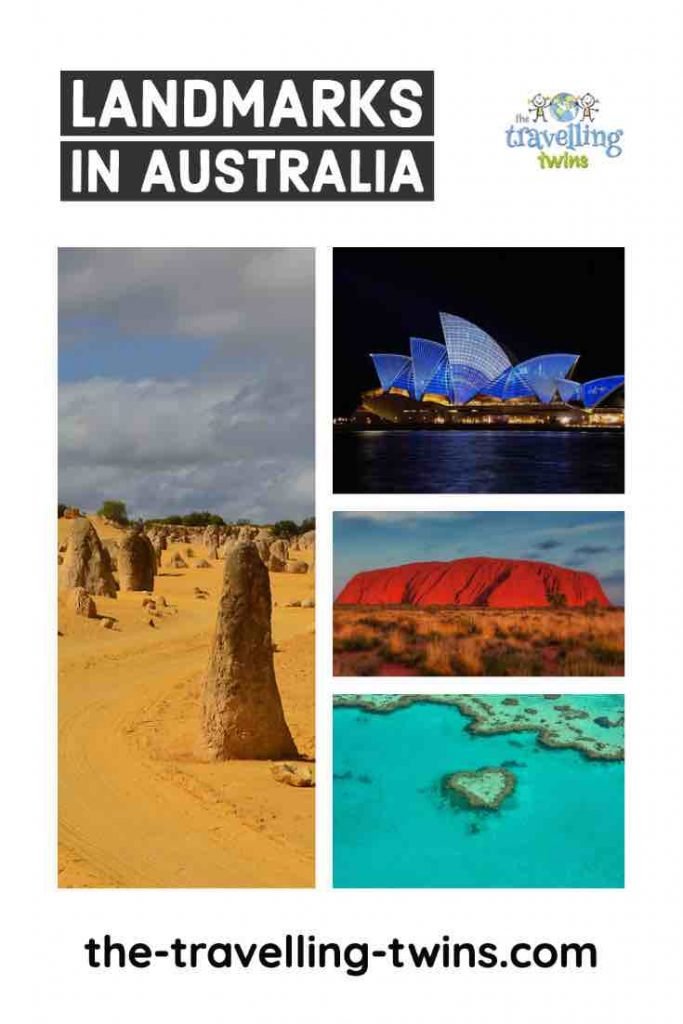
Landmarks in Western Australia
Pinnacles Desert
Like a scene from a sci-fi movie, the Pinnacles Desert is truly a sight like no other. Thousands of limestone pillars rising from yellow sand, some reaching up to 3.5m tall, make up the spectacular landscape of Nambung National Park. These unique formations are estimated to be around 30,000 years old and formed due to a combination of the receding ocean and windy coastal climate.
You will have the option to drive the loop that runs through the desert, with many spots to pull over and have a look around. Otherwise you can follow a walking path that leads you through the park to a lookout where you’ll find a panoramic desert view with the ocean in the background. As you explore the Pinnacles Desert, you can’t help but feel as though you’re on another planet! This national park is home to plenty of wildlife so keep your eye out for kangaroos, emus and cockatoos.
After your visit, make sure to take a look inside the Pinnacles Desert Discovery Center which gives you an explanation of the rock formations and surrounding landscape. The Pinnacles Desert can be reached by driving 2 hours north from Perth. It’s popular to visit on a day trip but it also makes an excellent stop on a west coast road trip itinerary.
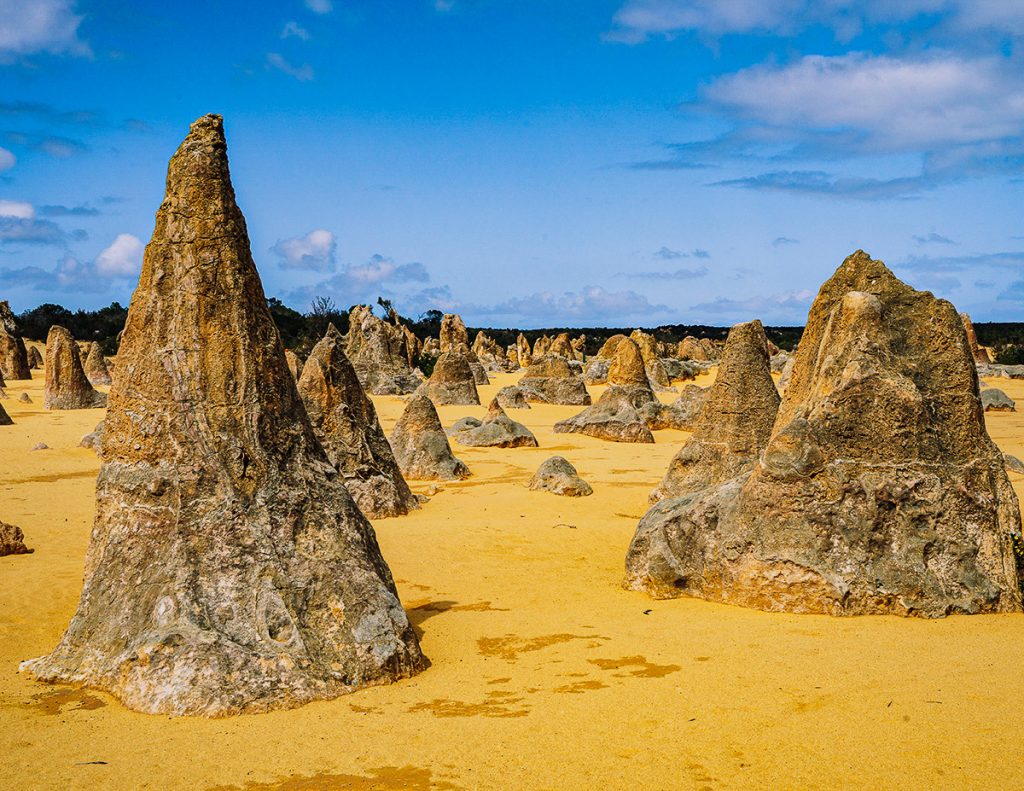
Contributed by Ann from The Road Is Life
Rottnest Island
Rottnest Island is easily the most popular tourist attraction in Perth, and for good reason, it’s absolutely stunning! This small island sits only 19 kilometers off the coast of Fremantle in Perth and makes for the perfect day trip from Perth, or even a couple-day getaway.
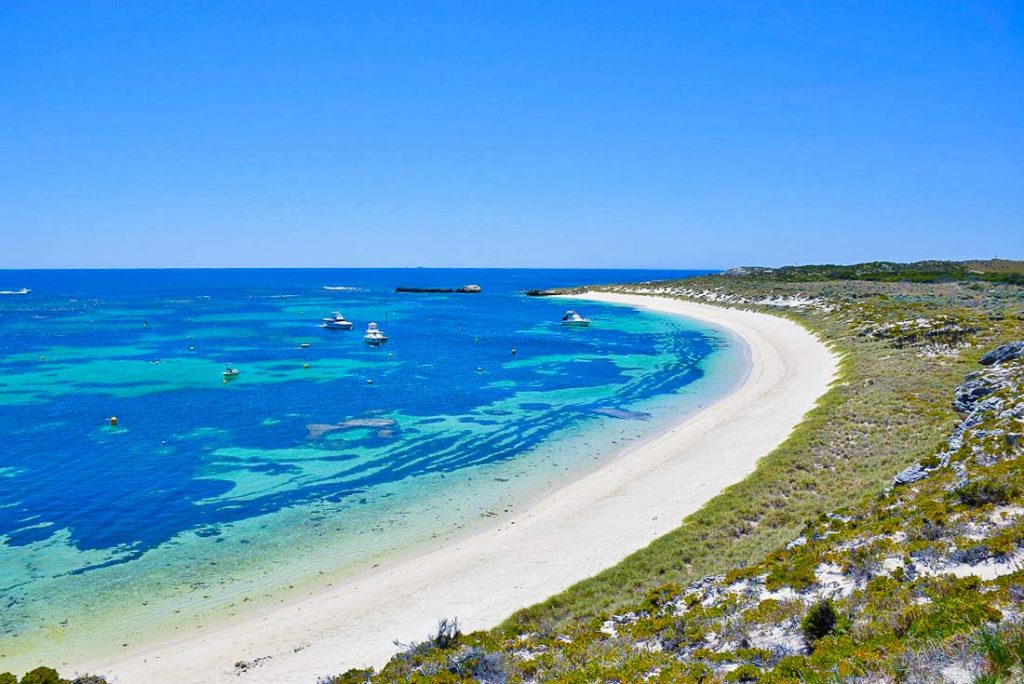
Rottnest Island is super popular for a few reasons. The first and most notable is its gorgeous beaches. All around the island are small beach bays comprised of white sand, crystal clear water, and amazing snorkeling opportunities. There are some larger well-known beaches, but you can also just explore and find your own private tiny beach. Snorkeling is very popular around Rottnest Island and you can find awesome snorkeling spots practically everywhere!
Getting around Rottnest Island is really easy too. Since the island is only 11 kilometers by 3 kilometers, it’s easy to get around on a bicycle. Once you arrive in Rottnest you can rent a bicycle from one of the stores right at the ferry dock and then be on your way exploring! Alternatively, there is a public bus system that stops at most of the main attractions around Rottnest.
Oh, and we can’t forget about Quokkas though! These furry little marsupials are the main residents of Rottnest Island and one of the main reasons people visit. Quokkas have no predators on Island and it is one of the very few places in Australia they actually live. They are friendly little guys and when you visit Rottnest Island, you most definitely will see a few Quokkas around!
Contributed by Bailey from Destinationless Travel
Wave Rock
Rising 15 meters tall, the Wave Rock is one of the largest waves in Australia and furthest from any major water body. It is believed to have been made more than 2,700 million year through natural causations.
The Wave Rock is situated near the small town of Hyden, around 340 kilometers from the city of Perth. Stretching 110 meters long, this psychedelic granite cliff is incredibly shaped like a gigantic wave that is about to crash onto the nearby plain.
It is one of the most interactive natural landmarks in Australia as visitors can pose on its face and surf the monstrous wave or walking up the summit.
The Kimberley
Located in Western Australia, Kimberly is an ancient natural landmark spanning hundreds of thousands of square kilometers considered to be one of the most exquisite wildernesses on the continent.
This wilderness frontier is three times the size of England, spreading over the entire northwestern edge of Australia. It is home to prolific wildlife, freshwater swimming ponds, large canyons, and many scrublands as well as the most famous 4WD road trips in Australia. Listed as a UNESCO World Heritage Site for its exceptional natural beauty, Purnululu National Park is located in northern Western Australia. Purnululu, also known from the Bungle Bungles Range, is one of the greatest gems of this wilderness known as Kimberley. Here, from the flat outback rise dozens of sandstone domes bandaged in orange and anthracite,
The origin of the famous domes of Purnululu dates back several hundred million years. Bungle Bungles Range is a multiple layer of sediment deposited at the bottom of an old river bed.
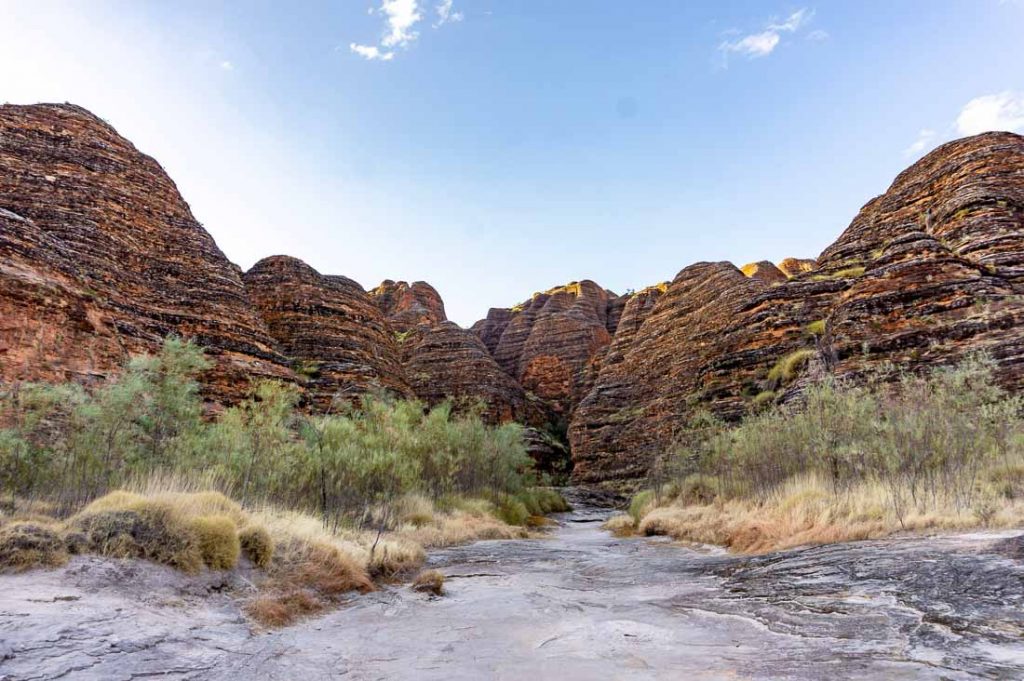
Lake Hillier
Lake Hillier was discovered by a Royal Navy explorer in 1802. The lake is distinct for its famous strawberry milkshake color. Located near the shire of Middle Island in the Recherche Archipelago in Western Australia, the peculiar color of the lake is not exactly known, though some quarters believe that it might be due to the numerous microorganisms that reside in the water.
More interestingly, Lake Hillier is separated by a thin strip from the blue waters of the Great Australian Bight.
According to the officials, it is absolutely safe to swim in the waters of Lake Hillier, and despite its scary pigmentation, the water cannot cause skin problems.
Ningaloo Reef
If you have ever dreamed of swimming with a whale shark, the Ningaloo Reef in Western Australia is the place to be. The crystalline water is home to the largest fringing reef in the world, stretching more than 250 kilometers. Here you will find a variety of tropical fish, turtles, manta rays, humpback whales as well as the mysterious whale shark.
It is only at Ningaloo Reef that the humpback whales and whale shark assemble in such large numbers.
The easiest way to reach Ningaloo Reef is flying from Perth to Learmonth Airport or drive from Perth, though it’s 1250 kilometers away.
Landmarks in Australia – New South Wales
Man made landmarks in New South Wales
Bondi Beach
Bondi belongs to one of the most popular suburbs of Sydney thanks to its coastal location. You can best take in all it offers on the famous Bondi to Coogee walk lining the coast.
The walk starts at Bondi Beach, the most iconic of all Australian beaches. The long and wide beach features light sand and stunning views out onto the ocean. The waves can get quite serious there and sometimes only a section of the beach is marked as safe for taking an actual dip in the water, let alone swimming.
Well, another, even better, option for swimming is the Bondi Ocean Pool, a.k.a. Icebergs Pool, named after the winter swimming team The Icebergs, who are based there. The pool lies on the Bondi to Coogee Walk too, just about 5-10 minutes away from Bondi Beach. There, you can swim in the refreshing waters of the South Pacific Ocean in a fine, 50m long Olympic pool. Even if you just walk by, it’s a uniquely beautiful sight. The swimming pool sits atop cliffs and the violent waves keep trying to crush it, so swimmers often get splashed from above.
The whole Bondi to Coogee walk is 6km long and takes you through the most beautiful beaches of the area including Tamarama, Bronte and Clovelly. There are many refreshment points along the way and a lot to feast your eyes upon. You can hike it whole or just do parts of it at a time.
An easy way to get to Bondi Beach, from where you can start the walk, is to catch any public transportation to Bondi Junction, a major hub, and then hop on a bus straight to Bondi Beach.
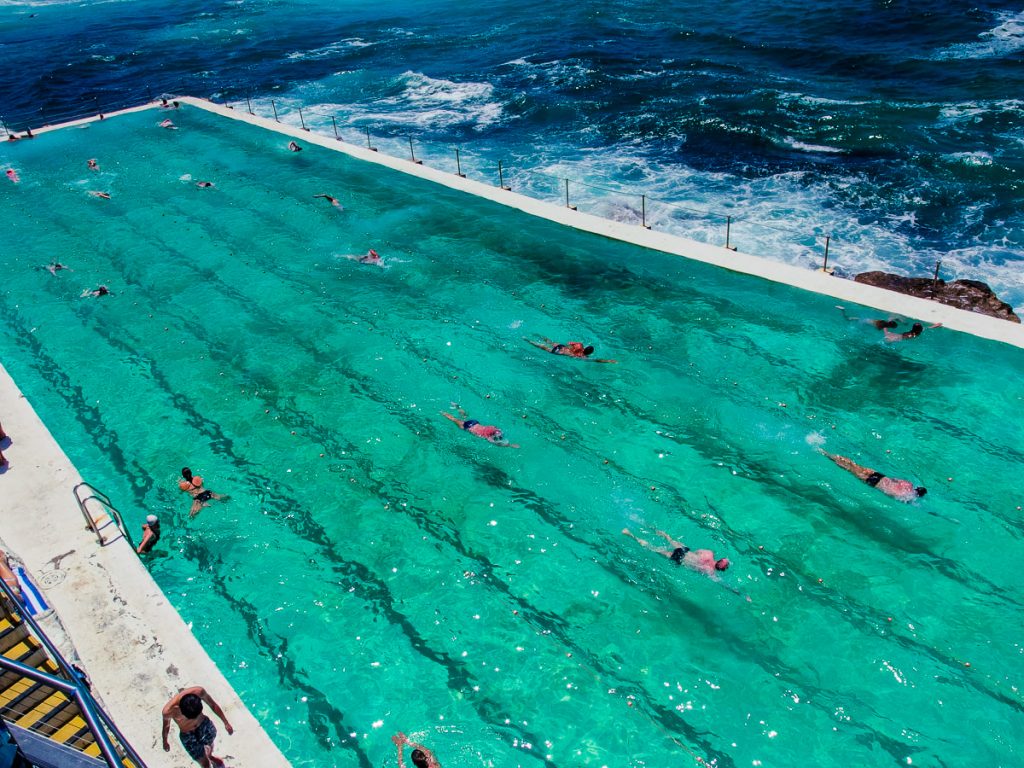
Contributed by Veronika Primm from Travel Geekery
Three Sisters Katoomba
While the Blue Mountains National Park is a wonder of vast landscapes and spilling waterfalls, and is a famous landmark in its own right, there is no part of it so iconic, well known and as instantly recognisable as Katoomba’s Three Sisters.
Standing guard at the edge of Jamison Valley, the sandstone rock formation was formed by erosion over time, leaving the three distinct rock formations all taller than 906 metres. Dreamtime legends of the local Aboriginal tribes tell of three sisters turned to stone to protect them from impending danger.
The sun rises roughly behind the sisters, and casts its light upon them as it sets, so any time of the day will offer good views, even shrouded in mist. The sisters are also lit up until 11pm at night for a night view. Most tourists head to Echo Point, about 2.5 kilometres from Katoomba train station, to view the sisters and their Jamison Valley backdrop, and since it’s a popular tourist attraction you can expect it to be busy most of the time. However, if you have a car and aren’t particularly attached to the idea of visiting and paying for parking at Echo Point, you can get an exceptional and much quieter view from Eagle Hawk lookout. You can also get an unobstructed view along the track to Katoomba Cascades, one of the best waterfalls in the Blue Mountains. More spectacular views are offered on the Three Sisters walk, which enables visitors to get up close and personal with the sisters.
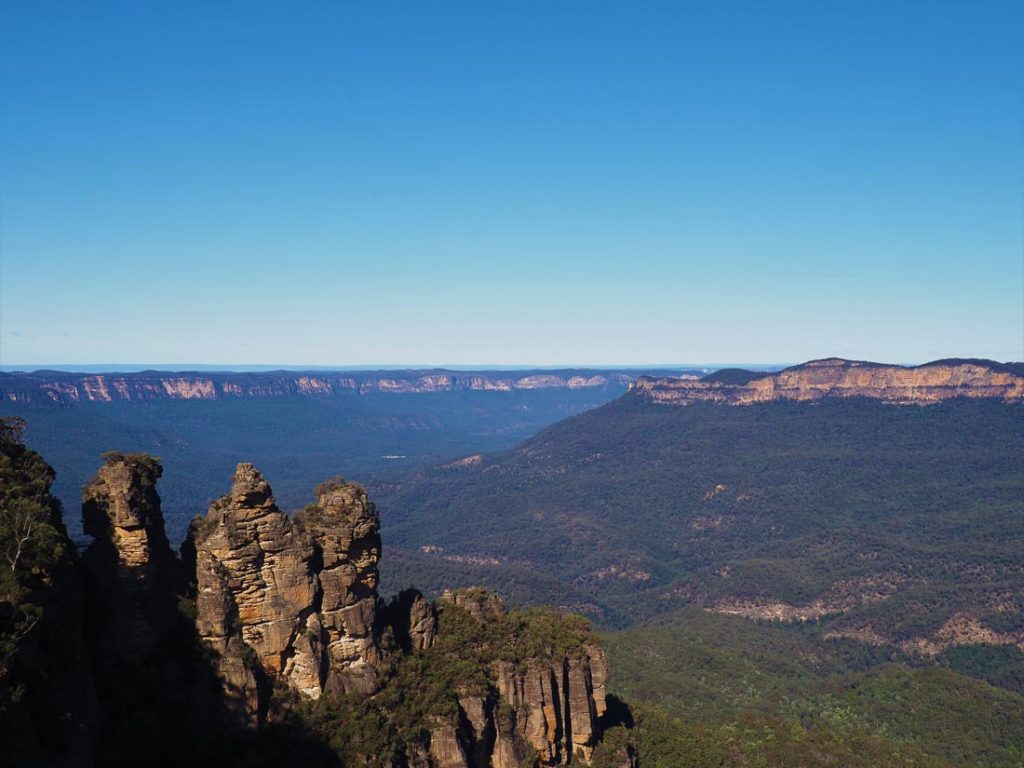
More spectacular views are offered on the Three Sisters walk, which enables visitors to get up close and personal with the sisters.
Contributed by Holly from Globeblogging
Jenolan Caves
The Jenolan Caves are a group of limestone caverns found inside the Jenolan Karst Conservation Reserve in the Central Tablelands region near the Blue Mountains. They are one of the finest and oldest cave systems in the world and comprise 11 show caves, astounding rock formations, and underground rivers.
It is believed that the caves have been in making for hundreds of millions of years, with information about its history shared on the guided tours.
There are accommodation options around the caves if you plan to spend overnight.
Royal National Park
This protected national park is located in Sutherland Shire in the state of New South Wales, south of the Australian city of Sydney. Founded by Sir John Robertson, this national park is the second oldest in the world after the Yellowstone in the United States.
The park consists of settlements of Maianbar, Audley, and Bundeena as well as a heritage tramway that is operated by the Sydney Tramway Museum. There are also several walking and cycling trails, picnic and barbecue spots.
More than 100 kilometers of walking paths take in a wide range of scenery, but the most popular walking track is Coast Walk, which starts at the eastern corner of the park and stretches 30 kilometers from Bundeena and Otford.
Kosciuszko National Park and mount Kosciuszko (Thredbo)
Spreading 6,900 kilometers, the Kosciuszko National Park is known for also containing the highest peak in Australia – Mount Kosciuszko. The park is surrounded by a mix of jagged mountains and wasteland, characterized by an alpine climate which is loved by bushwalkers and recreational skiers.
The highlight of the park is Mount Kosciuszko, mainland Australia’s highest peak at 2,228 meters above sea level.
Visitors can walk up the summit from Thredbo, a walk that takes between 3 to 3.5 hours for a round trip.
Man-made landmarks in New South Wales
Sydney Opera House and Sydney Harbour Bridge
Two of the most standout landmarks in Sydney are the Sydney Opera House and Sydney Harbour Bridge. These two iconic monuments are recognizable around the world and can be easily accessed or seen since they are both located in Sydney Harbour.
The Sydney Opera House designed by Jørn Utzon has for long been seen as an example of Australian architectural wonders. Situated overlooking the waterside, the building was opened in 1973 and went on to be one of the most iconic performing centers on the planet. The design of its exterior is meant to reminiscent of the sails of a ship.
On the other hand, the Sydney Harbour Bridge was opened in 1932, and at 134 meters tall, it is the tallest steel bridge in the world and the sixth-longest arch bridge, also in the world.


Sea Cliff Bridge
This 665-meter long bridge is the main highlight along the Grand Pacific Drive in Wollongong.it was opened in 2005; the Sea Cliff Bridge can be accessed via public transportation and offers visitors an opportunity to get out of the vehicle and stretch their legs before embarking on their journey. It is also a great spot for viewing migrating whales traveling north/south during the migrating season. Along the bridge, there are several stops on either side. Premier Illawarra Bus Number Two is known for offering transport services from Monday to Saturday.


Australian Parliament House – Canberra
The Canberra Parliament House is situated on Capitol Hill in the country’s capital Canberra. It is where the Australian members of parliament converge since 1988 when it was opened by Queen Elizabeth II. The House features a staggering 4,500 rooms and the famous mast with the country’s flag at its centre. It is said that the flag on the mast is almost the same size as a double-decker bus.
Visitors are allowed to explore large parts of the building and even watch parliamentary proceedings. The only time you will be required to buy a ticket is for Question Time in the House of Representatives, but even so, tickets are still free. There is also a free guided tour of around 40 minutes and depart from the entrance desk at 9.30 am, 11 am, 1 pm, 2 pm, and 3.30 pm.
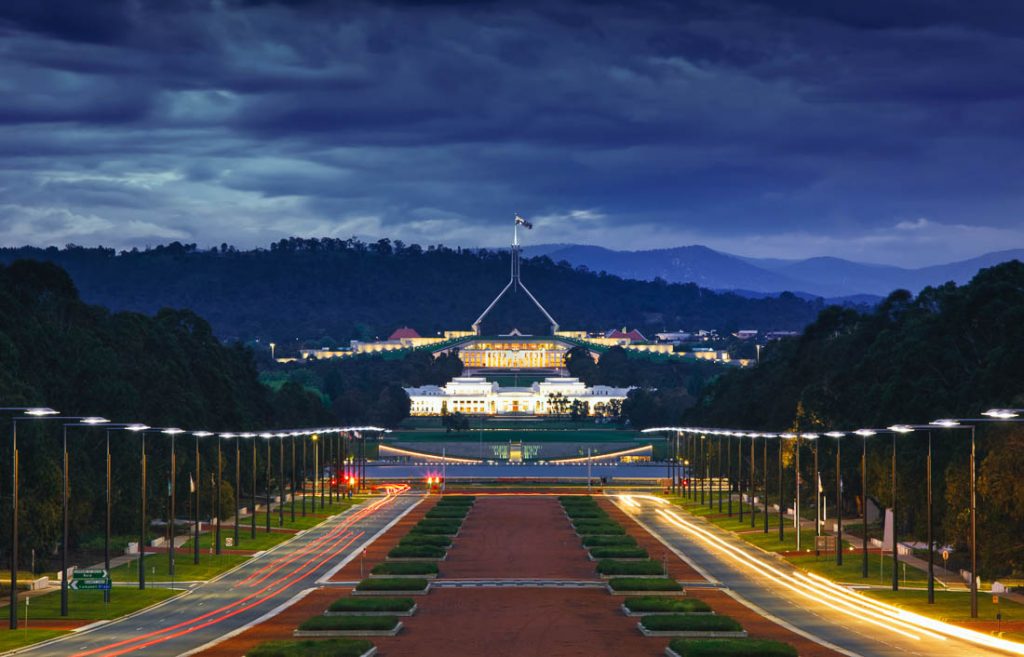
Australian War Memorial
The Australian War Memorial is located right by the Canberra Reservoir. It was brought in to commemorate all fallen Australian soldiers. Inside the mausoleum, there is also a museum worth visiting, which houses exhibits of war. In addition to exhibitions of remains from World War I and II, the building also houses a theatre and research site
Landmarks in Northern Territory Australia
Uluru – Ayers Rock
Almost 550 million years old Unesco World Heritage listed Uluru is in the heart of Uluru-Kata Tjuta National Park. It is an iconic landmark in Australia, and one of the few UNESCO World Heritage Site sites in the world recognised for both ecological and cultural value. According to the Anangu people, the incredible landscape is sacred and was a creation of their ancestors. It is a landscape that is spiritually rich with a long history, culture and folklore.
This iconic natural site is usually at the top of most travel wish lists, and it doesn’t matter how many photographs you look at, seeing this spectacular rock formation in real life is a breathtaking experience. One of the unusual things about Uluru is the color of the rock changes with the time of day.
Take a walking tour with an Anangu guide around the base and learn more about Uluru, Anangu traditions, medicines, food and rock art. And visit the Uluru-Kata Tjuta Cultural Centre to see traditional artwork and to learn about the Anangu people. This Australian park is a paradise for wildlife, and you are most likely to see kangaroos, wallabies and emus. Uluru is about 460 kilometres from Alice Springs and takes six hours to drive there. There are also commercial flights directly to Uluru.
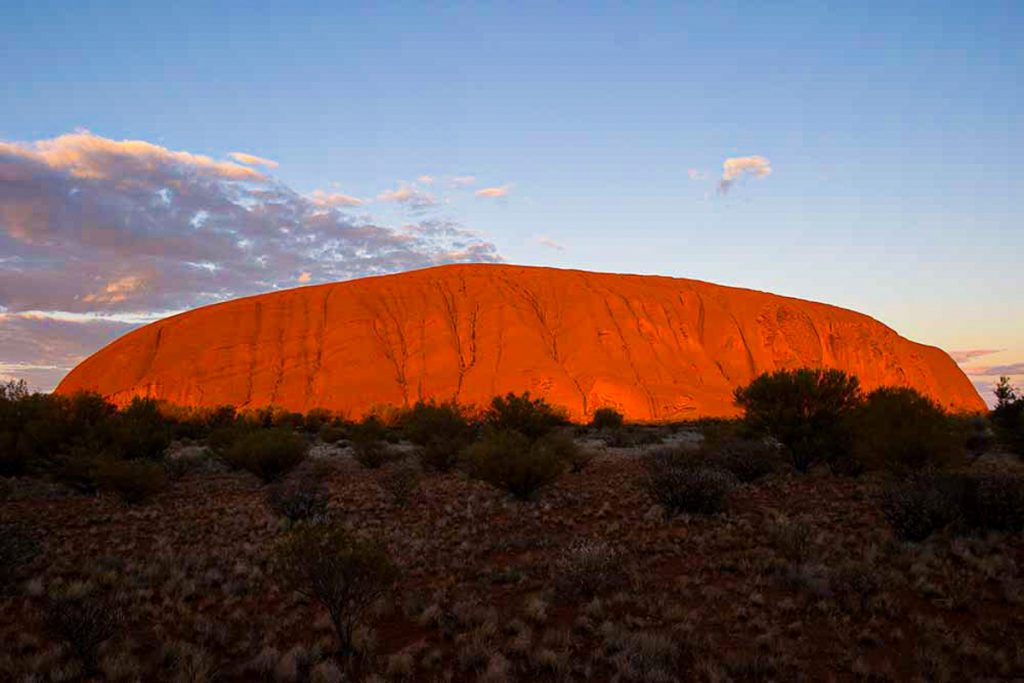
Contributed by Christina from Travel2next.com
Kakadu National Park
Kakadu National Park is one of Australia’s most beautiful places. Located a few hours from Darwin in the Northern Territory Kakadu is filled with classic Australian landscapes including breathtaking waterfalls, watering holes, bush walks, and pools.
A trip to Kakadu Park is considered one of the best things to do in Darwin and requires at least a one-night stay either at one of the campsites in the park or a hotel nearby. For me though, I love exploring the park on a guided 3-day tour. These tours include everything you need for an adventure as well A a guide who knows exactly where and how to get to the best spots.
Some of the most spectacular attractions in Kakadu include Twin Falls, Barramundi Gorge, Gunlom Plunge Pool, and the ancient shelters of Nourlangie. All of these places are all part of the typical Kakadu itinerary, but they all offer incredible views and places to cool off under the hot Australian sun.
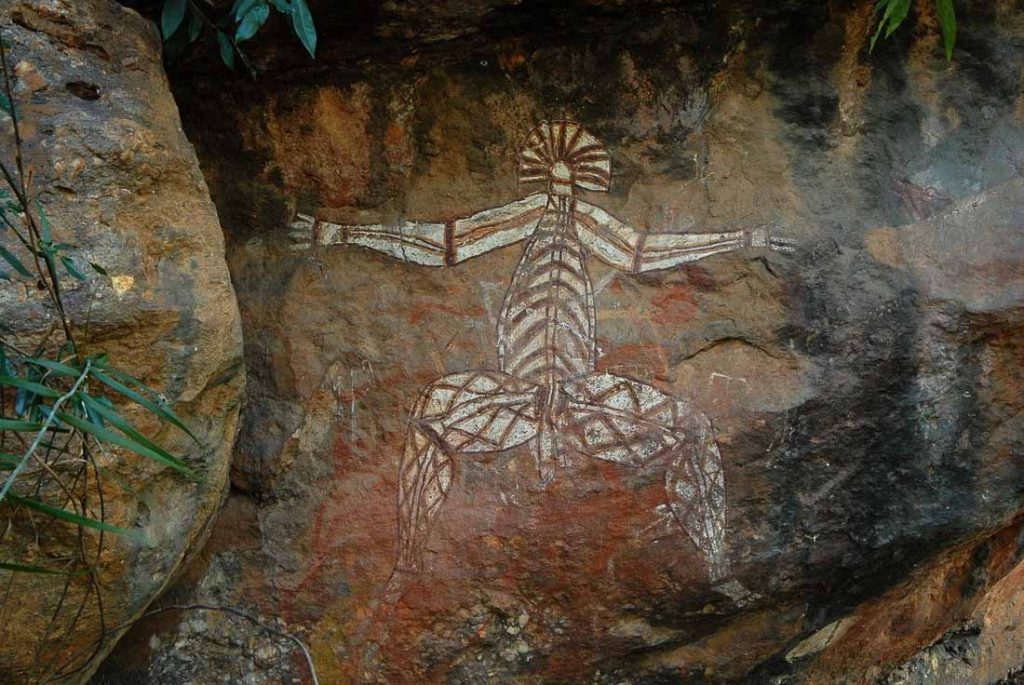
However, Kakadu is so much more than stunning landscapes. In fact, it’s home to some of Australia’s oldest aboriginal history. In northern Kakadu at a site called Ubirr, you can find one of the largest collections of Aboriginal art dating back as much as 20,000 year ago. These include handprints from other tribes who visited the area – it’s basically our version of a passport stamp!
Another cool attraction is Cahil’s crossing. This small river crossing bridges Kakadu to Arnhem Land and is home to one of the largest concentrations of saltwater crocodiles in Australia. In fact, over the span of 6 kilometers, rangers counted over 60 crocodiles! Luckily, visitors to the area can view the crossing from the viewpoint at a safe distance.
Regardless of the adventure you came to Australia for, the true outback of Australia is waiting patiently in Australia’s rugged and remote top end!
Contributed by Daniel Caracciolo from Destinationless Travel
Kings Canyon
Not to be confused with Nevada’s Kings Canyon National Park, Kings Canyon is a large canyon located in the Northern Territory in Australia near the western edge of George Gill Range. The nearest town is Alice Springs, which is around 323 kilometers away while Darwin is over 1000 kilometres further.
The canyons are more than 100 meters tall with Kings Creek sitting beneath. A section of the ravine is a sacred Aboriginal shrine and visitors are not encouraged to leave the walking paths.
For lovers of hiking, there are three walks at Kings Canyon, one of which ends with a platform for viewing over the canyon.
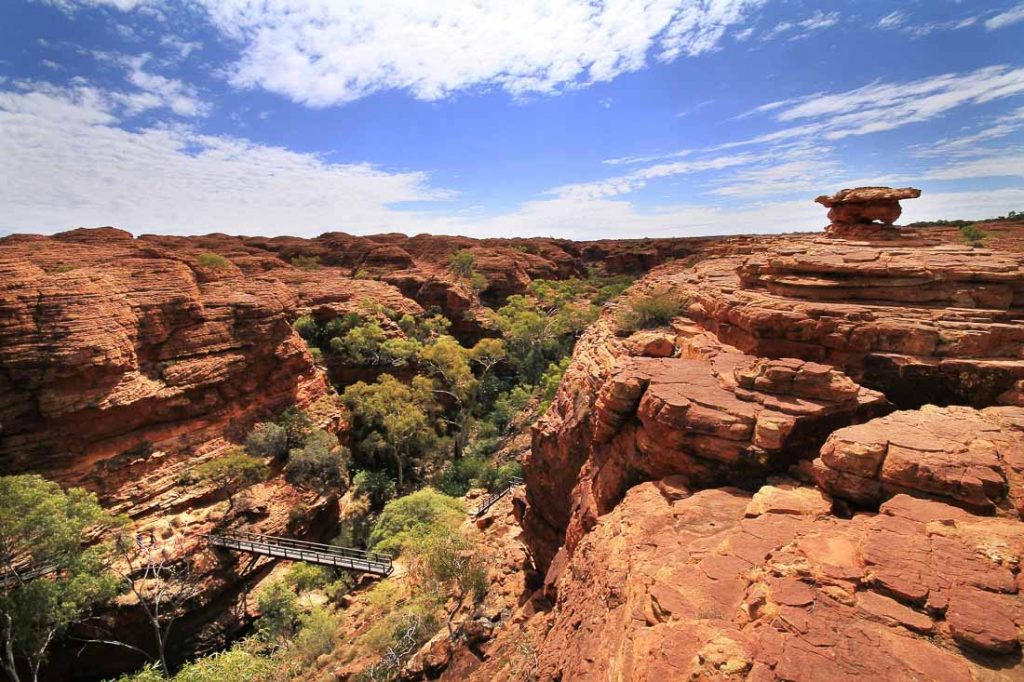
Litchfield National Park
Only an hour drive south of the small town of Darwin, Litchfield National Park is one of the beaten tracks in the Northern Territory. The park is known for its stunning waterfalls and ponds that are fringed by monsoonal vine forests, all of which combine to offer a much-needed respite from the scorching sun of Down Under.
You can drive through the park, which has a cabin, caravan, and camping sites within a walking distance. This park is a must-visit if you find yourself in the Top End. Swim below the falls and chill in waterholes for an unforgettable experience, especially in the summer.
Landmarks in Victoria Australia
NATURAL LANDMARKS IN VICTORIA
The Twelve Apostles – Great Ocean Road
One of the most well-known landmarks in Australia is the Twelve Apostles which majestically rise out of the ocean at Port Campbell along the iconic Great Ocean Road. These limestone pillars which are around 50 metres tall, date back to around 20 million year ago. The dramatic rugged cliffs on the golden sands create a stunning backdrop and the perfect photo opportunity, attracting visitors from all over the world.
Although named the Twelve Apostles, there are actually only 8 left at the moment. The limestone continues to be damaged by the waves and the wind, and one by one over the years they have disappeared, the last one to fall in 2005. Nobody knows how long these beauties will last.
The 12 Apostles are approximately a four hour drive along the Great Ocean Road which is an Australian National Heritage site. The 243km stretch winds along the Southern Ocean, and has some of the “best beaches near Melbourne“.
The road trip is worth the drive as there are plenty of stops to make along the way including the world-famous Bells Beach, the gorgeous Otway Ranges, and the historical town of Port Fairy.
If you have the time (and the budget), take a helicopter ride to get a birds eye view of these stunning natural wonders.
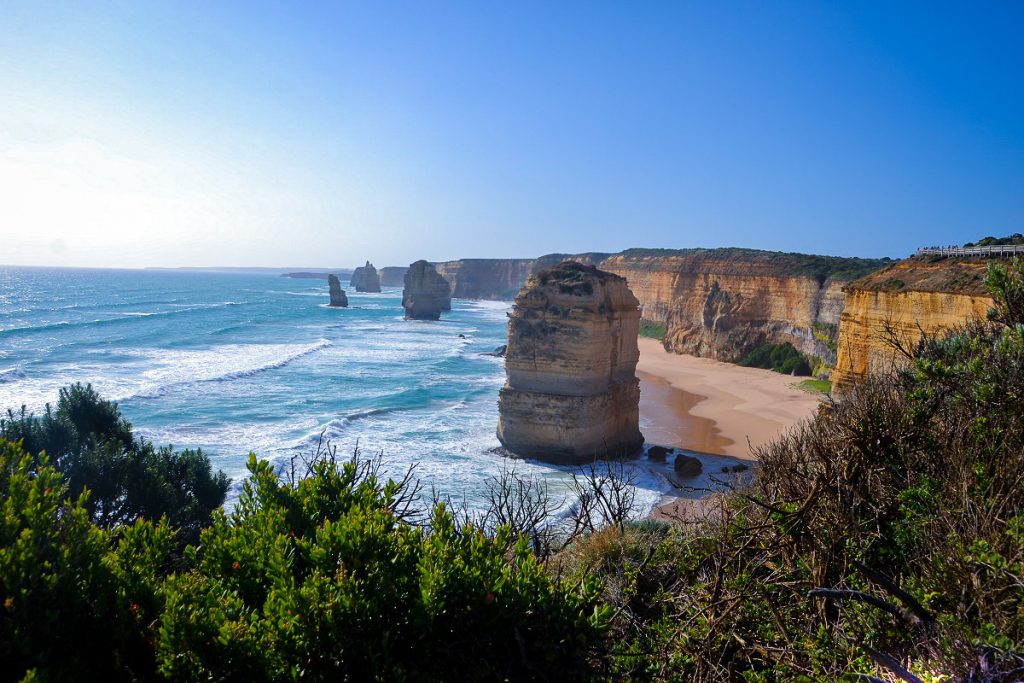
Contributed by Chontelle Bonfiglio from Mum’s Little Explorers
Loch Ard Gorge
Located within Port Campbell National Park in Victoria, the Loch Ard Gorge is a tourist attraction that was named after the clipper ship Loch Ard that navigate the Muttonbird Island in 1878 after leaving England three months earlier.
The gorge can be accessed through the Great Ocean Road, around 3.5 kilometers northwest of another famous nearby attraction, The Twelve Apostles. Stairs link the canyon with the beach beneath, while the paths enable easy access to the eastern parts of the gorge.
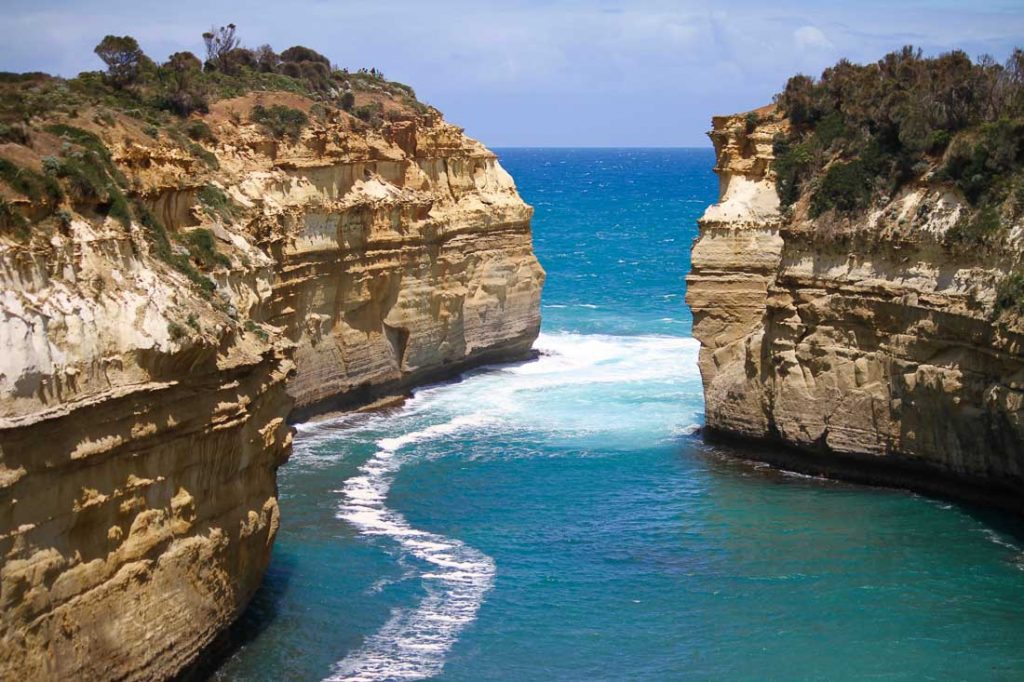
Phillip Island
Every day immediately after sunset, the world’s largest colony of Little Penguins puts on a mesmerizing show of about an hour as they toddle across the beach to their homes on Phillip Island. This daily parade is the highlight of the island and tends to draw thousands of tourists from all corners of the world.
You can get even closer to the action standing at the Penguins Plus viewing platform with a commentary from a warden.
Great Otway National Park
Spanning from Torquay, along the Great Ocean Road and through the Otway’s neighborhood, the Great Otway National Park is one of the most famous natural landmarks in Australia. Exploring this place gives you a chance to discover windswept coastlines as well as striking cascades in tall mountain forests.
There are plenty of outdoor activities within the Great Otway Park including walking to see the Twelve Apostles along the Great Ocean Walk.
Alternatively, you can just drive along the scenic Great Ocean Road, which was built by soldiers returning from World War I, thus it is the longest war memorial in the world.
Grampians National Park
The Grampians National Park is known for some of the world’s most famous hiking trails. Just like the Great Otway Park, the Grampians also features some majestic waterfalls, awe-inspiring mountain views, and alluring spring wildflower spectacles.
It is possible to come across and interact with wild animals such as kangaroos, emus, wallabies, and native birds while you go about your business at the park. Heritage-listed thanks to its diverse flora and fauna as well as the Aboriginal heritage and natural beauty, this park is one of the touristic spots in Australia.
Traditionally known as Gariwerd, the Grampians National Park is home to a wide range of important ancient Aboriginal shelters and rock art paintings.
Landmarks in Queensland
NATURAL LANDMARKS IN QUEENSLAND
Whitehaven Beach, Queensland
It would be impossible to talk about iconics landmarks in Australia without mentioning Whitehaven Beach. This iconic beach located in the Whitsunday Islands, off the coast of Queensland is the one you see on all the postcards in Australia!
It’s known to be one of the whitest and softest sandy beaches in the world! The sand is made of 98% of silica!
But the part that will really catch your attention is not even the beach itself, it’s the estuary at the end. This part is called hill inlet. It’s where the white sand and blue water meet creating the picturesque white and blue swirls! The best way to see it is from the Hill Inlet lookout. The views are jaw-dropping! It looks like a painting!
Although the Whitsunday islands are a popular tourist destination in Australia, there is no ferry going to this specific location. If you want to get to Whitehaven Beach, you can either opt for a tour or charter your own boat!
The Whitsunday islands are one of the rare places in the world where you can hire a boat without a license. It’s called bareboating. If you have the budget for it, it’s an experience of a lifetime. If not, don’t you worry! There are loads of cruises leaving from Airlie Beach every day!
Another way you can experience Whitehaven Beach is by going on a scenic flight from Airlie Beach. The flight lasts between 30 and 60 minutes. You will be flying above the islands, heading to Whitehaven Beach and then to the Great Barrier Reef. It’s also the only way to see the heart reef!
Whitehaven beach is one of the most beautiful places on earth so make sure you add it to your bucket list, you won’t be disappointed!
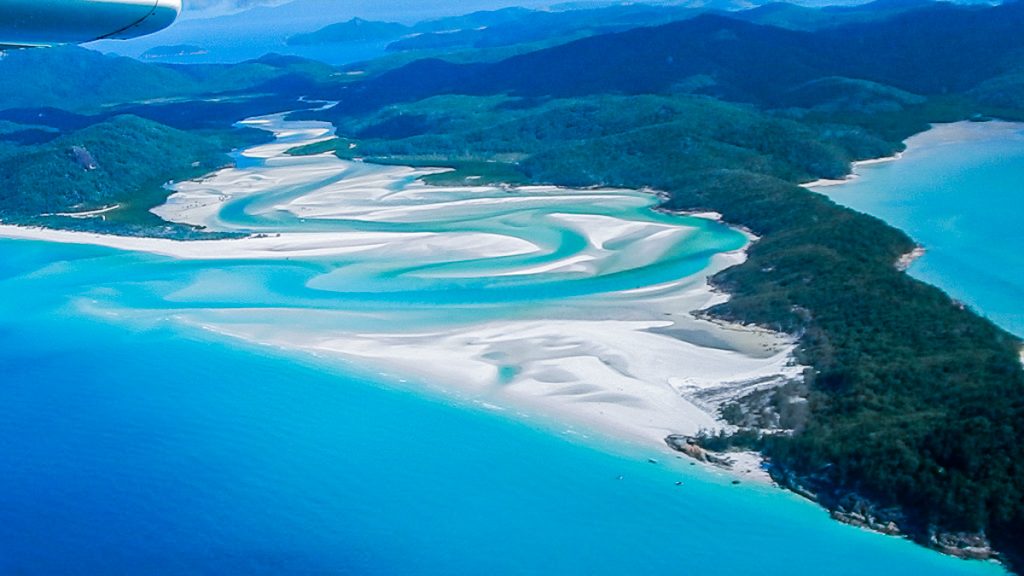
By Pauline from BeeLoved City
Tip of Australia
The Tip of Australia, as you may have guessed, is the northernmost point of mainland Australia, some 32 kilometers from Bamaga. It is one of the most breathtaking places in Australia and offers beautiful views across the often emerald blue Indian Ocean.
From Peak Point, you can be able to see Possession Island, where there is a small monument that marks the spot where Captain Cook raised the flag of England as a sign of claiming New Wales in the late 1700s.
Paronella Park
This world heritage-listed park lies within Mena Creek in Queensland, around 120 kilometers south of the city of Cairns. The park was built by a Spanish immigrant called Jose Paronella in the 1930s. Visitors to the park are taken on various guided tours where they listen to the story about the history of the park.
In 2004, the park was awarded Queensland’s premier significant attraction by the Queensland Tourism.
Great Barrier Reef
Another world heritage site, the Great Barrier Reef is the largest coral reef system in the world, consisting of more than 2,900 reefs and 900 islands spanning more than 2,300 kilometers over an area of 344,400 square kilometers. The reef is part of the Coral Sea just off the shoreline of Queensland.
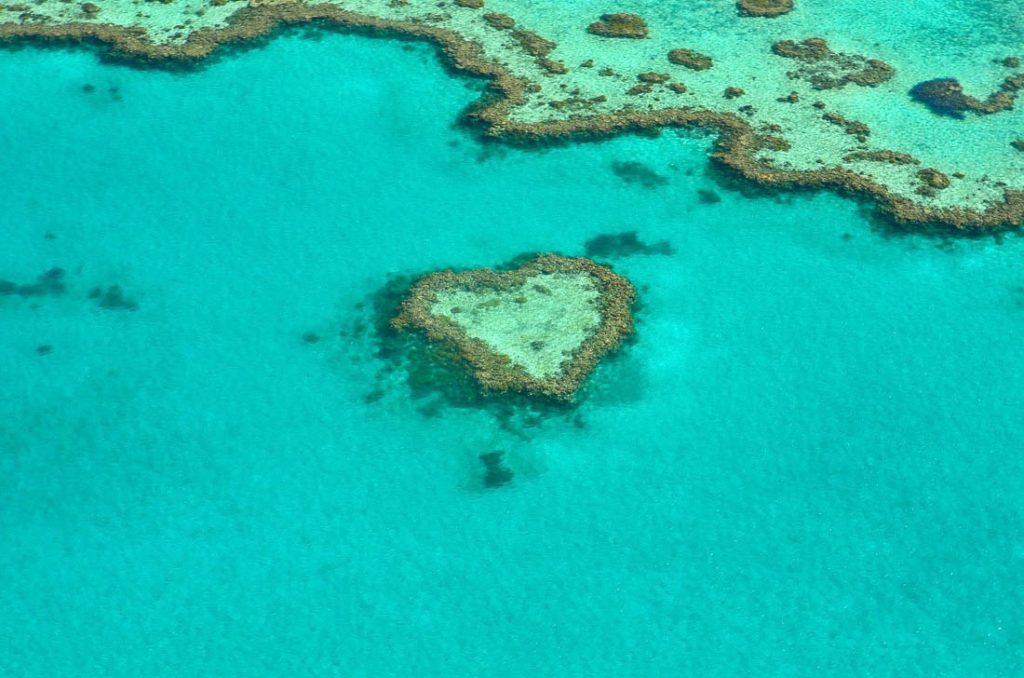
A large section of the reef is under the Great Barrier Reef Marine Park, which protects it from the impact of tourists. The reef can be accessed through international flights to Cairns Airport or domestic flight to Hamilton Island.
Fraser Island
Fraser Island is also a heritage-listed landmark in Queensland, Australia. It is located along the southeastern shore in the Wide Bay-Burnett region around 250 kilometers north of Brisbane. Known locally as K’gari, this island exudes natural beauty and history at every turn. It is characterized by lush rainforests, sparkling lakes, and endless white beaches.
The island is also home to the famous dingo among many other wild, dangerous animals. With that in mind, Fraser Island’s beaches are usually waddled with dangerous riptides as well as sharks and marine stingers including Blue Bottle and Irukandji Jellyfish.
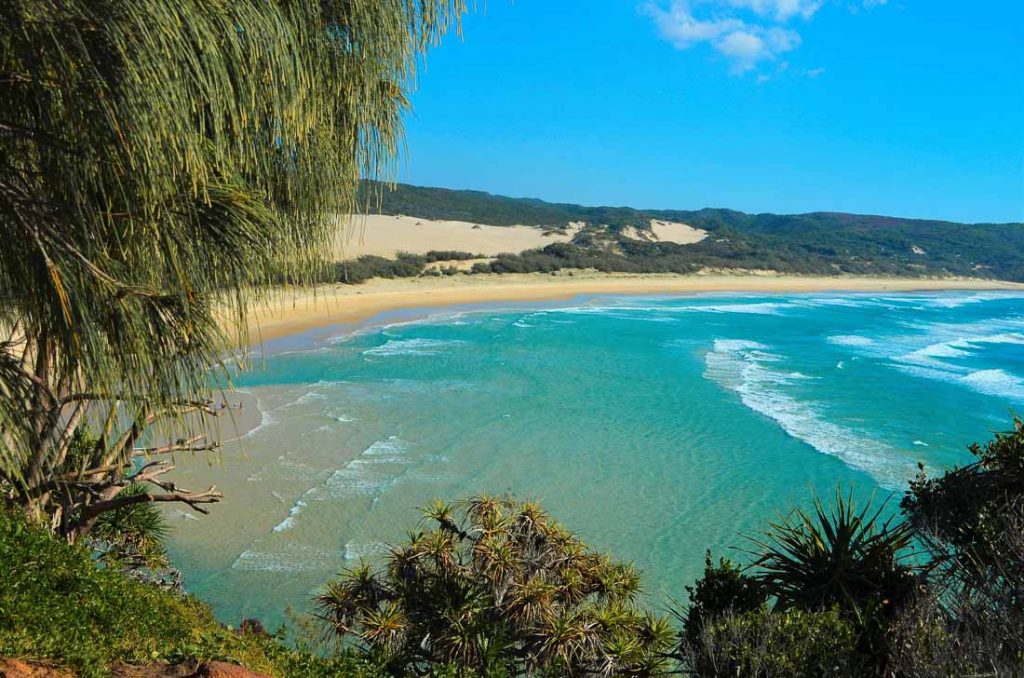
Green Island
Green Island is located in the Cairns region in Queensland within the Great Barrier Reef Marine Park World Heritage Area. The island is bordered by a coral reef and is under the protection of the Green Island National Park.
In terms of access, visitors can reach the island through seaplanes, helicopters, and charter boats. Among the activities to do on the island include boat snorkel trip, glass-bottom boat tour, scuba diving, seawalker, and helicopter scenic flights.
Daintree Rainforest
The Daintree Rainforest is located along the northeast coast of Queensland, north of Cairns and Mossman. Spreading approximately 1,200 square kilometers, the rainforest is made up of the largest continuous tropical rainforest on the continent. It was named after an Australian photographer and geologist Richard Daintree and the forest comprises the Daintree National Park, sections of State Forest, and private lands.
Springbrook National Park
Located in the Gold Coast hinterland of Queensland, the Springbrook National Park is punctuated by spectacular waterfalls, ancient trees, lush rainforest, exceptional ecological significance, striking views, and an abundance of natural beauty.
Springbrook National Park is part of the Gondwana Rainforest of Australia World Heritage Area and a world heritage site.
Lamington National Park
This landmark lays on the Lamington Plateau thin the McPherson Range on the border of Queensland with NSW. The park is also close to the Springbrook National Park.
In addition to a number of guest houses, there is also a campground in the Green Mountains as well as a privately run campground near Binna Burra.
MANMADE LANDMARKS IN QEENSLAND
Story Bridge
The Story Bridge is a prominent landmark on the inner Brisbane city skyline carrying more than 97,000 cars per day across the Brisbane River between Fortitude Valley and Kangaroo Point.
Australia’s longest cantilever bridge took five years to complete during the Great Depression and was officially opened in 1940. The bridge was named after the prominent public servant, John Story, who advocated for the bridge to be built.
While the grey steel girders blend into the cityscape during the day time, it is at night that the Story Bridge comes into its own. The impressive structure becomes a prominent feature of the Brisbane night skyline with brightly coloured lights creating stunning reflections on the Brisbane River and the surrounding buildings.
There is a Light Up Brisbane calendar that the Brisbane City Council use to raise awareness for local charities by displaying their corporate colours on the bridge at night. Special days of the year are also represented with the bridge lit up in green and gold for Australia Day or maroon, Queensland’s official state colour, for the heavily contested State of Origin football competition against New South Wales.
The Story Bridge becomes one of the main focal points at events such as Brisbane Riverfire and New Year’s Eve celebrations when it becomes a launching point for fireworks.
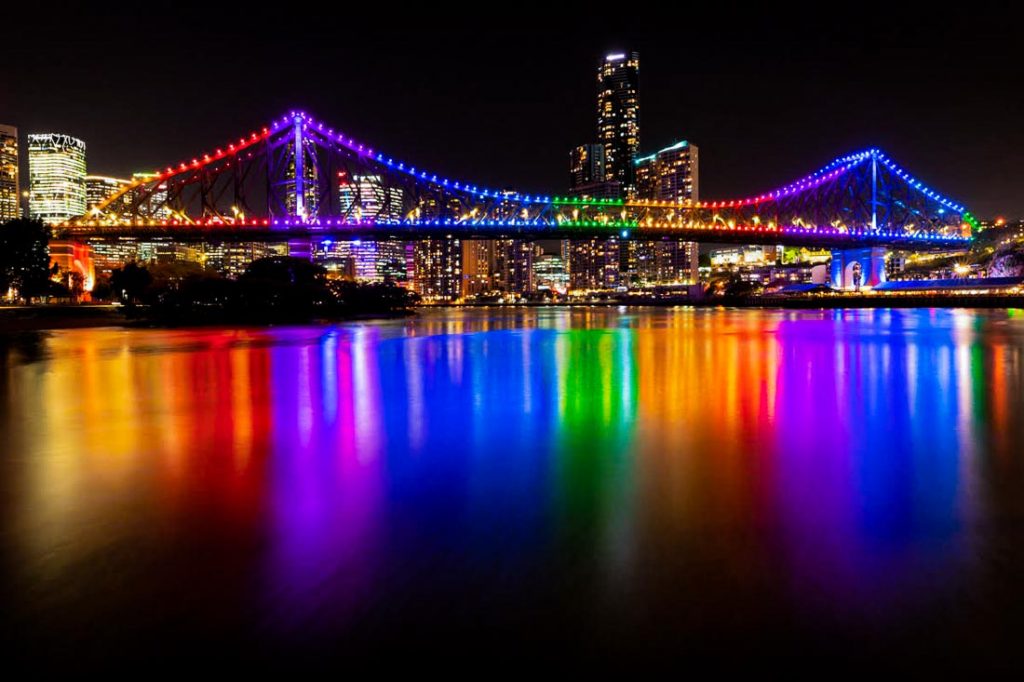
Susan Gan from Australia Bucket List
Landmarks in Tasmania
Port Arthur – Tasmania
Australia’s past as a convict settlement is an important part of the countries colonial history. Nowhere has this been better preserved than at Port Arthur on the east coast of Tasmania.
Port Arthur was originally settled in 1830 to take advantage of the areas rich timber reserves. However, because of its isolation and position on the Tasman Peninsula it was decided it was the ideal place for a prison.
From 1833 to 1853 Port Arthur took those convicts considered both the most serious offenders and the greatest flight risk. As well as men, boys as young as 9 years old were also sent there. It was run with some of the harshest rules of any convict settlement in Australia.
After 1853 the site ran as a prison until 1877. After it closed, the site fell into disrepair until 1927 when its potential as a tourist site was recognised. From that point on, Port was progressively managed and restored to being one of Tasmania’s and Australia’s most significant historical sites.
Today, a visit to Port Arthur is a great day trip from Hobart. When we visited, we were struck by the contrast of the beauty of the site and its brutal reputation. The grounds are beautifully manicured, and there are over 30 building to look through. Your ticket provides admission for two days and it’s no wonder, there is a lot to see!
Included with your entry is a cruise into the bay that takes you around the Island of the Dead and an introductory walking tour. In addition to those, there are half a dozen other tours you can pay for including an evening ghost tour and a ‘True Crime’ tour that tells the tales of some of Port Arthurs more notorious residents.
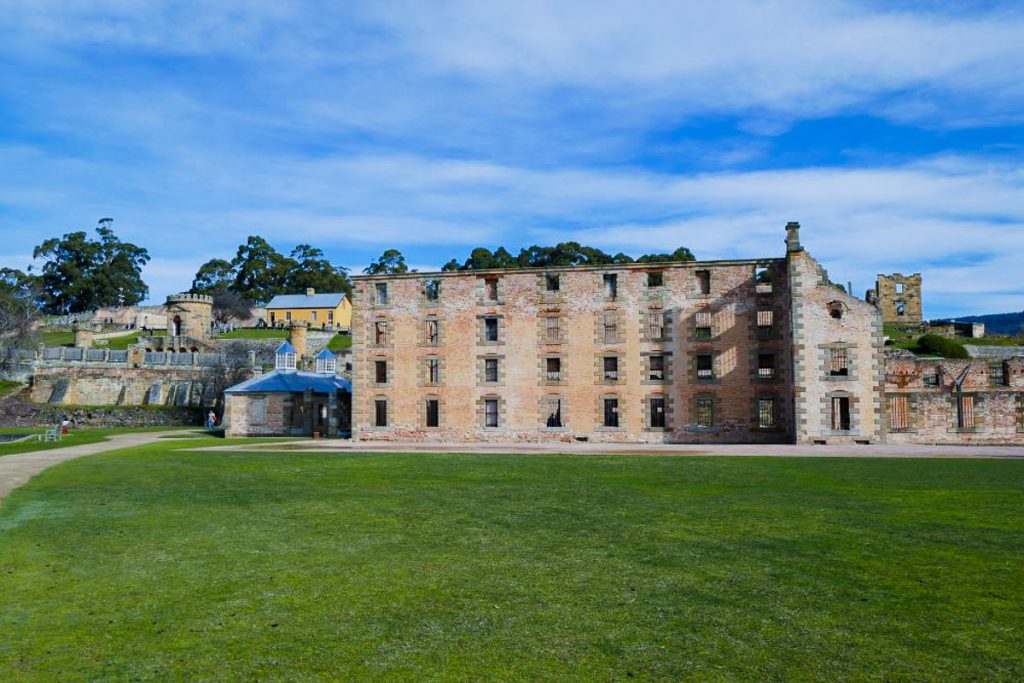
Contributed by Natalie & Steve from Curious Campers
Freycinet National Park Wineglass Bay
Wineglass Bay is well known thanks to being regularly listed as one of the top 10 most beautiful beaches in the world. Famous for its orangey red and pink granite formations which add to its beauty along with the powder white sand and clear blue water, its name has a much darker meaning. It comes from the 1820s when the bay was home to whalers who would harpoon nearby whales and drag them to the shores of this beach to butcher. This stained the blue water red, resembling a fine red wine and thus the bay was named Wineglass Bay.
Thankfully, today, none of this past remains. In fact, Wineglass Bay is located on the sunny east coast of Tasmania within Freycinet National Park. It’s location within the national park means that it’s not possible to drive to this beach which adds to its charms. Instead, there is a one hour hike to the beach up and down between two peaks with many stairs along the way. The upside of this is not just less crowds, but you get great views from Wineglass Bay Lookout on the way over which is one of the most photographed views in the state.
On arrival, spend some time enjoying the beach. Swimming is possible although its likely to be quite fresh. Tasmania National Park fees apply to visit here.
Contributed by Sharon Gourlay from Tasmania Explorer
Cradle Mountain
The Cradle Mountain is found in the Central Highlands of the Australian state of Tasmania, in the Cradle Mountain-Lake St Clair National Park. At 1,545 meters high, the peak is the sixth-highest in the state. The mountain emerges from the glacially formed Dove Lake and has four summits that are so far named.
It has an array of day walks that take visitors through a wide range of landscapes.
Mount Field National Park
This national park is located about 64 kilometers northwest of the nearest city of Hobart. The landscape around the park ranges from alpine moorland to eucalyptus temperate rainforest. The park was founded in 1916, thus making it one of the oldest national parks in the state of Tasmania.
Visitors can enjoy camping as well as cabins owned by the government. There are also a number of ski/walking clubs with private huts.
Besides the numerous accommodation centers, there are also barbecue and picnic facilities and a playground area.
Bay of Fires
The name might be ominous, but the Bay of Fires is truly a lovely place to visit if you are in Tasmania. It was named by Captain Tibias Furneaux in 1773 after he saw the forms of the local Aboriginal people along the beaches. With that in mind, the area has some of the best beaches in Australia as well as stunning waterfalls, scenic walks, and oyster farms.
Lord Howe Island
Lord Howe Island is a volcanic island located in the Tasman Sea between Australia and New Zealand which was discovered on February 17, 1788, when Lieutenant Henry Lidgbird Ball, commander of HMS Supply, was on his way from Botany Bay to Norfolk where he planned to establish a settlement. As a result of a mistake, however, he sent a group of his people to Lord Howe Island, claiming that it was a British property – thus the island was first settled.
Over time, the island became a harbor for the whaling industry and for the next generation it lived its own peaceful life. When the industry collapsed, in 1880, world exports of endemic Kentia palm species began, and to this day remains a vital element of the island’s economy. The second industry, tourism, began after World War II.
Lord Howe is registered by UNESCO in the World Heritage List of Natural Importance. Most of the island is virtually untouched, with many plants and animals found nowhere else in the world. The island and its values create a variety of landscapes, a variety of ocean basalts, a location next to a coral reef, and a rich historical and cultural heritage.
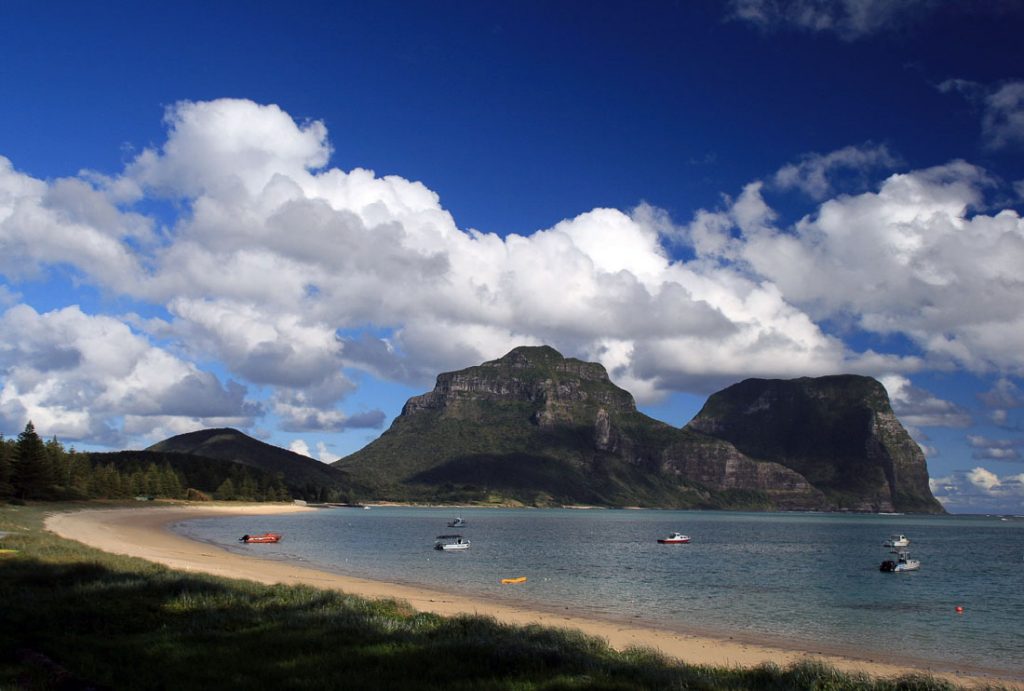
Famous Australian Landmarks – Pin it for later



Privacy Policy Disclaimer
This website uses affiliate links for income and support.
If you like our website, please consider using these links. You will be directed to the vendor, and we will get a small commission on your purchase price at no increased cost to you.
We have researched facts stated here as far as practicable but please check anything critical before committing your time and money. We do not claim any special knowledge or expertise, and we are not consultants for our readers.